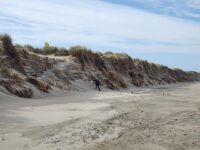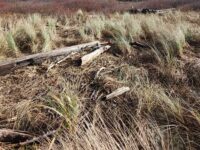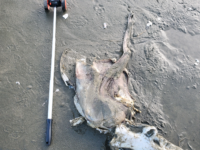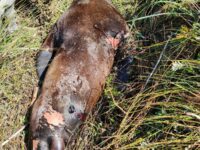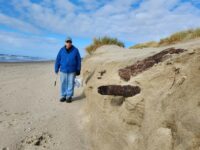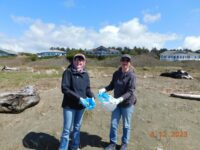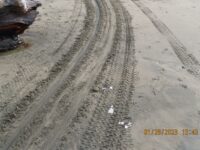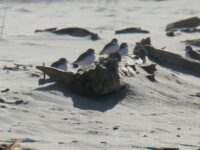Mile 203 Report
Driftwood Beach south, Hidden Lake
March 17, 2019
It was a nice day, but windy, with many people walking or playing with dogs.
Report Details
It was a nice day, but windy, with many people walking or playing with dogs. We monitered the dogs to see if there was any disturbance of sea birds and we did not see any. The number of large jellies on the beach was substancially higher than we have seen before. The micro plastic build up is sad and people commented on the increase in the small pieces. We did find a large chunck of a marine animal but could not accurately identify it. The chunk is about 4 feet long and 2 feet wide. It looks like it was washed very high up into a puddle area a while ago. It is breaking down but until the vultures return other animals don't see to be feeding on it. We are including a picture if any one can identify it.
Conditions
Temperature: 56 F. Wind Velocity: Moderate. Wind Direction: NW. Tide Level: 0.0 feet.
Human Activities
Number of people: 32. Number of dogs: 9. Walking or running: 31. Sitting: 1. We wonder why people bag their dog droppings and then leave the plastic bag with the droppings on the beach. Each time we go to the beach we find two or three bags like this.
Dead Fish or Invertebrates
Unusual concentration. There were 68 jellies, 10 inches to 15 inches wide, near the water and high up on the tide line.
Driftline Content
Seaweeds and seagrass, Animal casings (e.g., crab, shrimp molt), Wood pieces, Land-based debris (picnics, etc.), Marine debris (plastic, styrofoam, etc. washing in from the sea), Styrofoam, Ocean-based debris (from fishing boats, ship trash, etc.). The micro plastics, 5mm square or smaller, are laid out in ribbons about 10 to 15 feet long in the drift lines. All the micro plastic is north of access 66c.
Natural Changes
The dunes and grass areas that were north of access 66C have been filled in with sand. The area affected goes from Access 66C to the north end of Sand Piper Village. Other people we talked to on the beach in the affected area commented on the same thing. Shore birds used to nest in this area.
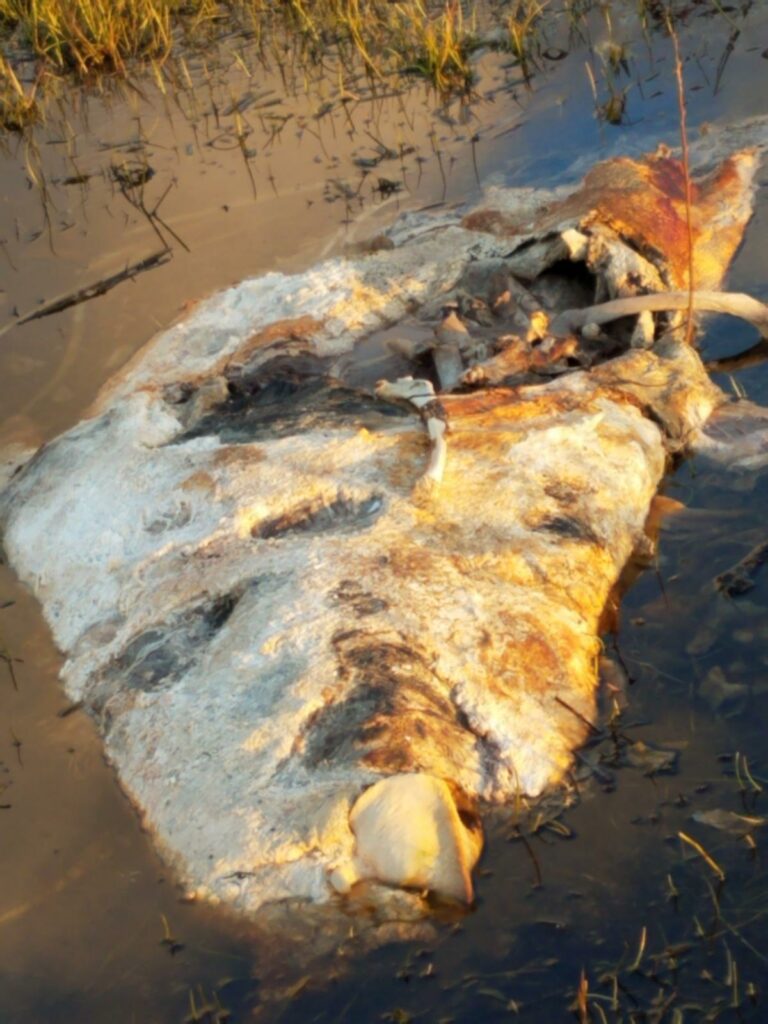
Report Images
All Mile 203 Reports
Mile 203
Driftwood Beach south, Hidden Lake
We found 7 lbs 12 oz of marine and ocean debris on the beaches in the wrackline area. The north and south ends of mile 203 show evidence of substantial wave erosion of the dunes.
Jeff Hildreth
Mile 203
Driftwood Beach south, Hidden Lake
The beach has had substantial washing away of old dunes and washing up of beach grass into the dunes. There were 45 bird carcasses of we believe are Cassin's auklets.
Jeff Hildreth
Mile 203
Driftwood Beach south, Hidden Lake
Today I and my two CoastWatch partners conducted a NOAA Marine Debris survey on our 100 meter survey site at Sandpiper Beach, Mile 203. On reaching our marine debris survey site, we saw a lot of Cassin's Auklet carcasses, which COASST calls CAAU, all high up on the beach among the beach vegetation and washed-in sea grass, many carcasses partially covered by sand or vegetation. After we completed our debris survey, I returned to our survey site and began collecting CAAU carcasses in groups of 9, as COASST recommends, ultimately collecting 40 carcasses in 4 full and 1 partial grouping. Below is a link to our Sandpiper Beach NOAA debris survey site where most CAAUs were found, reached by a boardwalk that enters the beach midway in the debris survey site. COASST defines a "wreck" as more than 20 beached individuals of one species per kilometer, and a "MME" (Massive Mortality Event) as a spike of up to hundreds of carcasses per kilometer. We also found a beached Northern Fulmar and what is I believe was either a female Gadwall or White-winged Scoter, which I took note of but didn't measure or report on to COASST. I submitted documentation with photos of the CAAU beaching event to COASST, and COASST responded that they had received reports of CAAU beachings from Southern Oregon sites like Coquille Point and Cape Blanco but also as far north as Manzanita. All this sounds very dry, but it was really sad to see and handle all these beautiful little dead birds and wonder if this is completely natural or if climate change, and perhaps a decline of prey species making these birds more vulnerable, factors into these mortality events. https://mdmap.
Jon French
Mile 203
Driftwood Beach south, Hidden Lake
The storms and rain caused some beach washout from the ocean and from the land.
JLcoasties
Mile 203
Driftwood Beach south, Hidden Lake
The dunes have reappeared due to the spring winds.
JLcoasties
Mile 203
Driftwood Beach south, Hidden Lake
Last year at this time, Jesse Jones helped us set up a 100 meter NOAA marine debris survey site on Mile 204, which we later moved to Sandpiper Beach on Mile 203.
Jon French
Mile 203
Driftwood Beach south, Hidden Lake
It was a beautiful day for a walk.
Nancy Thomas
Mile 203
Driftwood Beach south, Hidden Lake
After observing 8 snowy plovers on Mile 200 yesterday, I wanted to check up on the plovers on Mile 203.
KFunk

